Introduction
In our tech-driven world, mobile devices need a way to be uniquely identified, just like we do. That’s where the International Mobile Equipment Identity (IMEI) number comes in—a unique code that acts as a fingerprint for your phone.
But why is the IMEI number so important? In this guide, I will explain what the IMEI is, how it works, and why it is essential to keep it noted.
Table of Contents
What is an IMEI number?
An International Mobile Equipment Identity (IMEI) number is a globally unique identifier assigned to individual mobile devices. No two mobile devices on the earth can share the same IMEI number, as this would violate the principle that an IMEI uniquely identifies a device worldwide.
You can compare IMEI numbers to MAC addresses, which serve as unique identifiers for Network Interface Cards (NICs). If you are unfamiliar with MAC addresses, you can learn more here.
Mobile devices that rely on technologies under the of 3GPP umbrella–such as 2G, 3G, 4G and 5G–are assigned IMEI numbers. In simpler terms, any device with a SIM card or eSIM capability has a IMEI number. These numbers are essential for activating both physical SIM cards and eSIMs.
Devices with dual SIM capabilities have two IMEI numbers, typically labeled IMEI1 and IMEI2. If your phone has only one SIM card slot but two IMEI numbers, IMEI1 is for the physical SIM, while IMEI2 is for the eSIM.
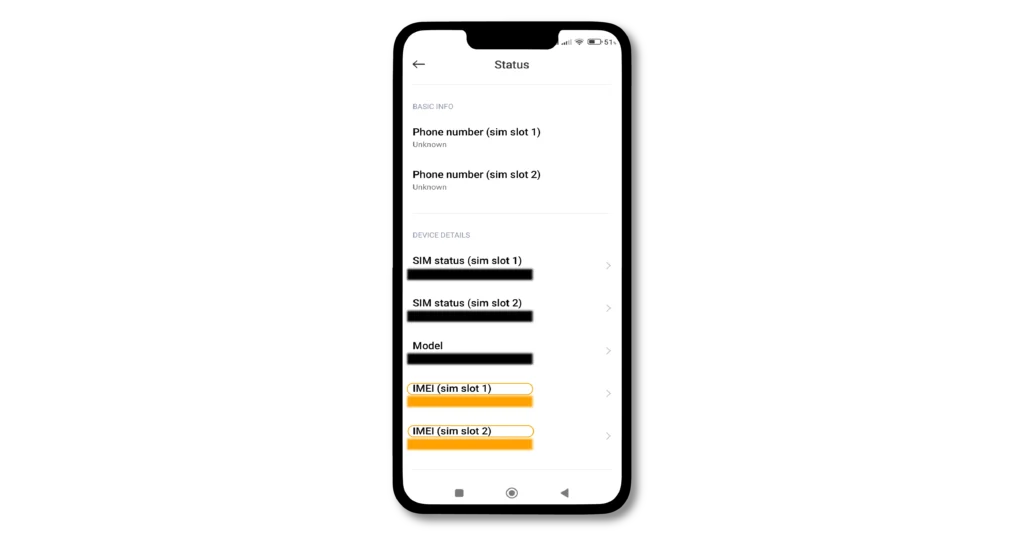
In contrast, devices without a SIM card slot or eSIM capability typically don’t have an IMEI number.
It is important to note that IMEI numbers are tied to the mobile device, not to the SIM card. So, changing SIM cards will not alter the device’s IMEI number.
For clarity, SIM stands for Subscriber Identity Module, and eSIM stands for embedded SIM, which is a form of SIM card integrated directly into the device. 3GPP stands for the 3rd Generation Partnership Project, a consortium of several organizations that develop mobile telecommunications protocols.
Understanding the IMEI Format
The structure of an IMEI number reveals important information, such as the mobile device’s manufacturer, Model Number, and the organization that issued the number, along with other relevant information.
The GSM Association (GSMA) is the Global Decimal Administrator (GDA), a role it has held since 2004. Some of its responsibilities include:
- Appointing regional bodies to allocate TAC/IMEI ranges
- Maintaining lists of allocated TACs/IMEIs
- Providing expertise and guidance on allocations
As you read further, this concept will become clearer–stick with me!
An IMEI number consists of 15 decimal digits. Each digit ranges from 0 to 9.

According to the GSM Association (GSMA) documentation on the IMEI allocation process, IMEI numbers follow the format: RRMMMMMMSSSSSSC, which has been valid since 01/01/2003:
Each segment of this format has a specific meaning. Let’s break it down into three portions:
| TAC | Serial No. | Check Digit |
|---|---|---|
| RRMMMMMM | SSSSSS | C |
Here’s the meaning of each segment:
| TAC | Type Allocation Code |
| RR | Reporting Body Identifier |
| MMMMMM | Model Number Identifier, defined by the Reporting Body |
| SSSSSS | Serial number for each device of a particular model |
| C | Check Digit, a function all other digits |
Let’s break down the IMEI format more clearly. It is divided into three portions: the TAC, the Serial Number of the mobile device of a particular model, and the Check Digit.
For completeness, it is important to introduce the term ME, which stands for Mobile Equipment. This term appears in official documentation and refers to any mobile device assigned a unique IMEI number. I will use the term Mobile Device for simplicity throughout this guide.
It is worth mentioning that there was an older format for the IMEI, structured as follows:
| TAC | FAC | Serial No. | Spare Digit / Check Digit |
|---|---|---|---|
| RRMMMM | FF | SSSSSS | C |
FAC stands for Final Assembly Code, consisting of 2 digits. It identifies the specific manufacturing site of the mobile device.
If the last digit is a Spare Digit, its purpose has not been defined, and it is always transmitted to the network as “0”.
If you would like to learn more about this format, check out the “Additional Resources” section to download and read the referenced document.
Let’s continue with the current format of the IMEI number.
TAC – 8 Digits
A TAC is an 8-digit decimal number that identifies a manufacturer’s mobile device model, and the regional organization that issued and approved that number. It consists of two parts: the Reporting Body Identifier and the Model Number Identifier.
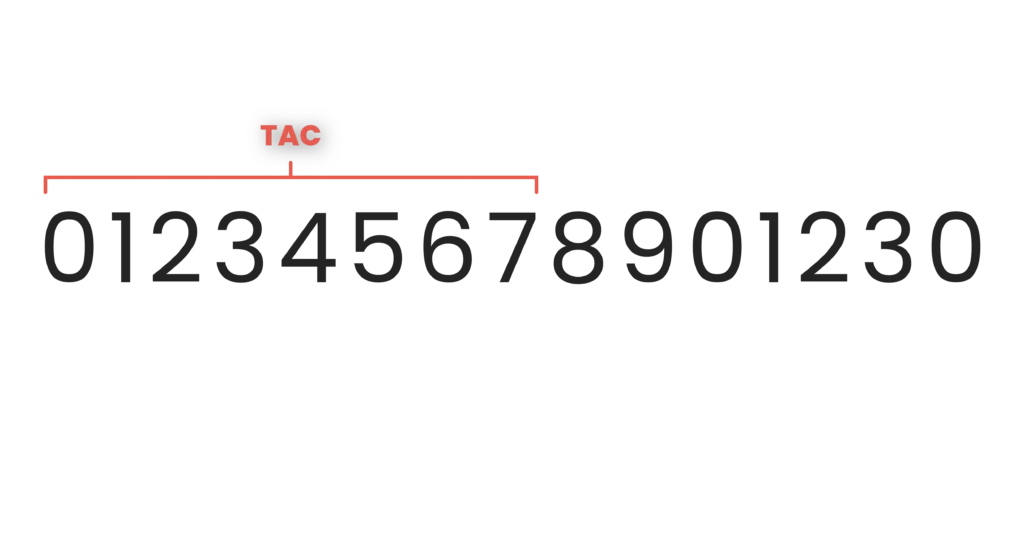
The term Type Allocation refers to the process of assigning a unique TAC for a manufacturer’s mobile device model. Therefore, the Type Allocation Code (TAC) obviously is the allocated 8-digit number.
Reporting Body Identifier – 2 Digits
The Reporting Body Identifier is the first portion of the Type Allocation Code (TAC), consisting of 2 decimal digits. It uniquely identifies the regional GSMA-authorized organization that assigned an IMEI to a specific mobile device model. For example, the identifier “86” which refers to TAF (Telecommunication Terminal Testing & Approval Forum in China).
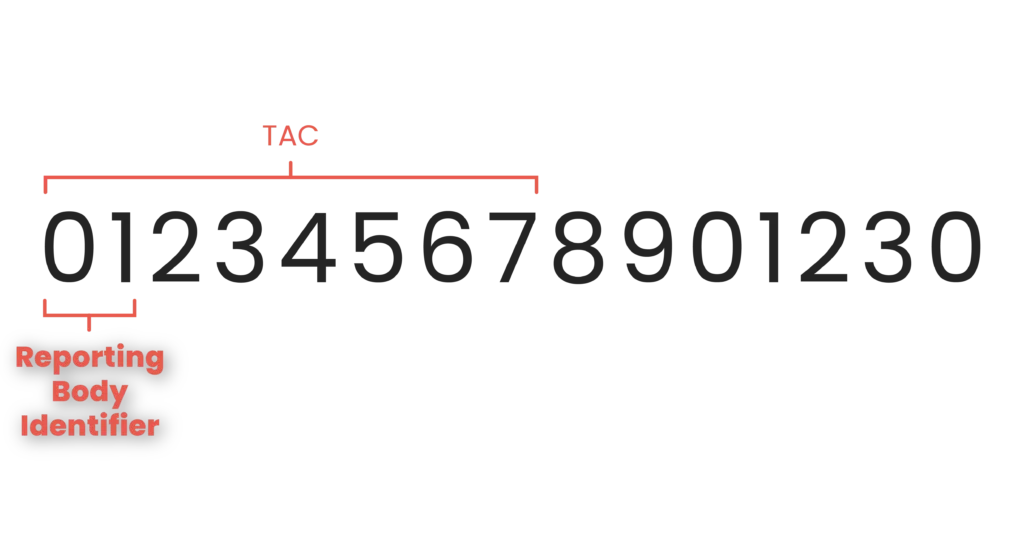
The Reporting Body Identifiers are managed and assigned by the GSM Association (GSMA).
You can check your Reporting Body Identifier using the table provided in the downloadable file mentioned in the “Additional Resources” section. Press here for a direct jump.
Model Number Identifier – 6 Digits
The Model Number Identifier is the second portion of the Type Allocation Code (TAC), consisting of 6 decimal digits. It is defined and issued by the Reporting Body. Together with the 2 digits of the Reporting Body Identifier, this number uniquely identifies a manufacturer’s mobile device model associated with that IMEI.
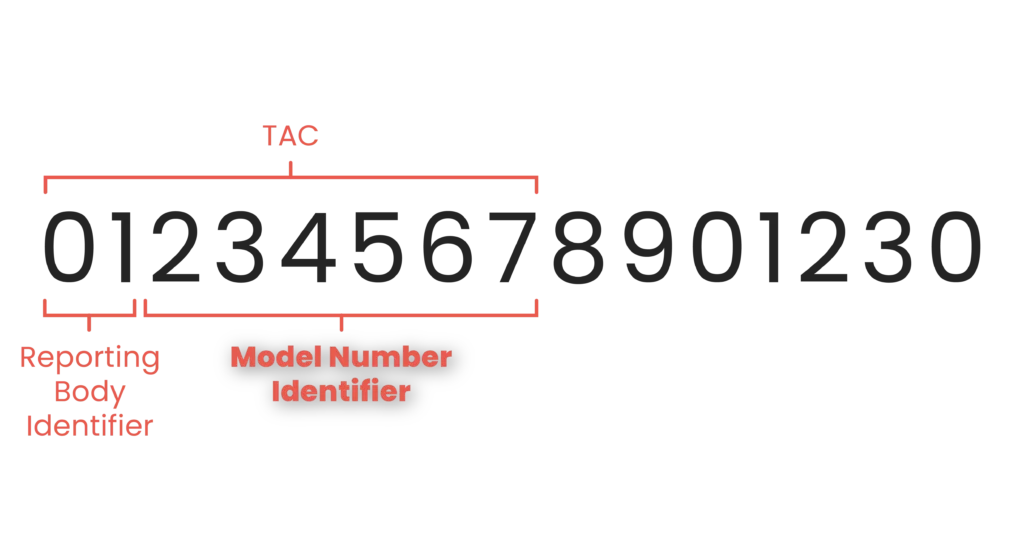
Here are some rules that apply to the TAC portion:
- Each mobile device model must have a unique TAC.
- The TAC shall uniquely identifies each mobile device model.
- A mobile device model can have more than one TAC because the Model Number Identifier in the TAC is limited to 6 decimal digits, which allows for a maximum of 999,999 identifiers. To accommodate more than one million Model Number Identifiers, additional TACs can be allocated.
Serial Number – 6 Digits
The Serial Number is the second portion of the IMEI number, consisting of 6 decimal digits. It uniquely identifies each mobile device of a particular model and is assigned by the manufacturer. The Serial Number can range from 0 to 999,999, as allocated by the Reporting Body.
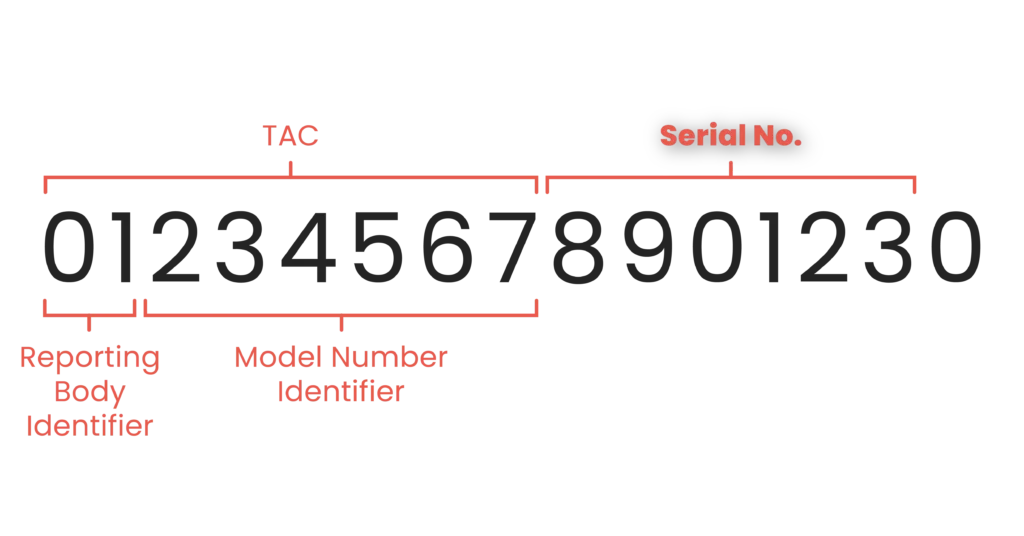
Note that each mobile device of each model must have a unique Serial Number for a given TAC, which is the first portion of the IMEI number.
Check Digit – 1 Digit
The Check Digit is the third portion of the IMEI number, consisting of 1 decimal digit. It is calculated based on all other digits using the Luhn formula. The Check Digit is essential for error checking to ensure the number’s validity.

The Check Digit helps guard against incorrect entries in the Central Equipment Identity Register (CEIR) and EIR equipment, as well as detecting errors in reading or manually transcribing of the IMEI.
It is important to note that the Software Version Number (SVN) is not included in the calculation of the Check Digit.
Software Version Number – 2 Digits
The last component often presented alongside the IMEI number is the Software Version Number (SVN), consisting of 2 decimal digits. The SVN is a separate field from the IMEI and enables the mobile device manufacturer to identify different software versions of a given mobile device.
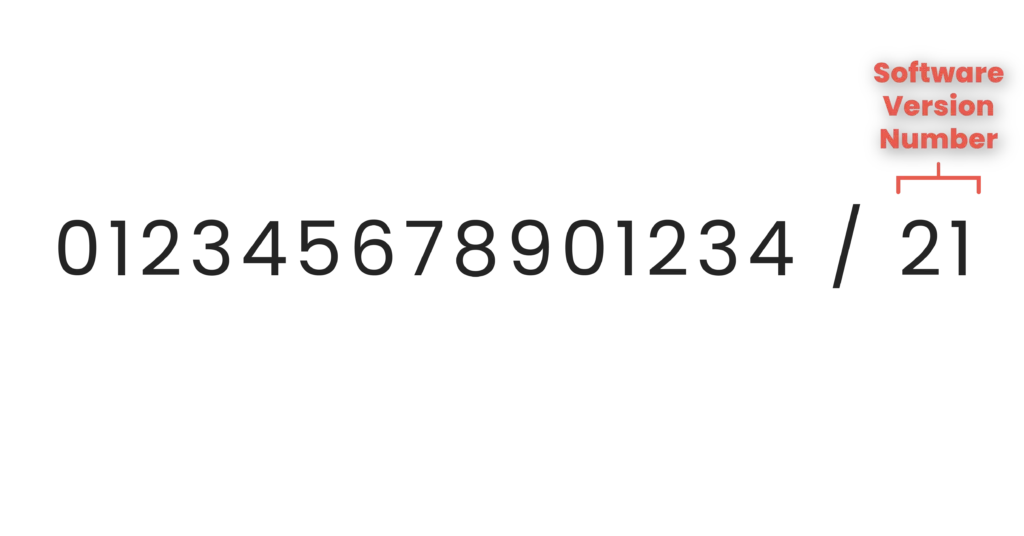
The assignment process for the SVN can occur in two ways:
- The Reporting Body assigns a new SVN for every new software release.
- The Reporting Body defines the assignment process that the manufacturer or brand owner must follow.
The SVN value of 99 is reserved for future use. If more 99 software versions are released, the Reporting Body may issue a new TAC for the mobile device model.
Understanding the IMEISV Format
The IMEISV consists of the IMEI and the SVN, but it does not include the Check Digit. The format of the IMEISV is as follows:
| TAC | Serial No. | SVN |
|---|---|---|
| RRMMMMMM | SSSSSS | VV |
Here’s the meaning of each segment:
| TAC | Type Allocation Code |
| RR | Reporting Body Identifier |
| MMMMMM | Model Number Identifier, defined by the Reporting Body |
| SSSSSS | Serial number for each device of a particular device model |
| VV | Software Version Number (SVN) |
The network can request the IMEISV from a mobile device. When the network requests the IMEI, the SVN (if present) is also sent to the network.
Key Benefits of Having an IMEI
- Facilitates the identification of mobile devices sold in unofficial markets.
- Enables cellular network carriers to trace and track mobile devices.
- Prevents stolen mobile phones from accessing and being used on cellular networks.
- Assists customs agencies in verifying the authenticity of devices in some countries.
- Allows for better control and management of mobile devices on a network.
- Helps identify which devices are responsible for technical faults, enabling remedial actions.
Methods to Reveal Your Phone’s IMEI Number on Android and iOS
Revealing your mobile device’s IMEI number is straightforward. You can try the following methods, starting with the easiest:
- Dial
*#06#from your device. The IMEI number(s) will be displayed on-screen.
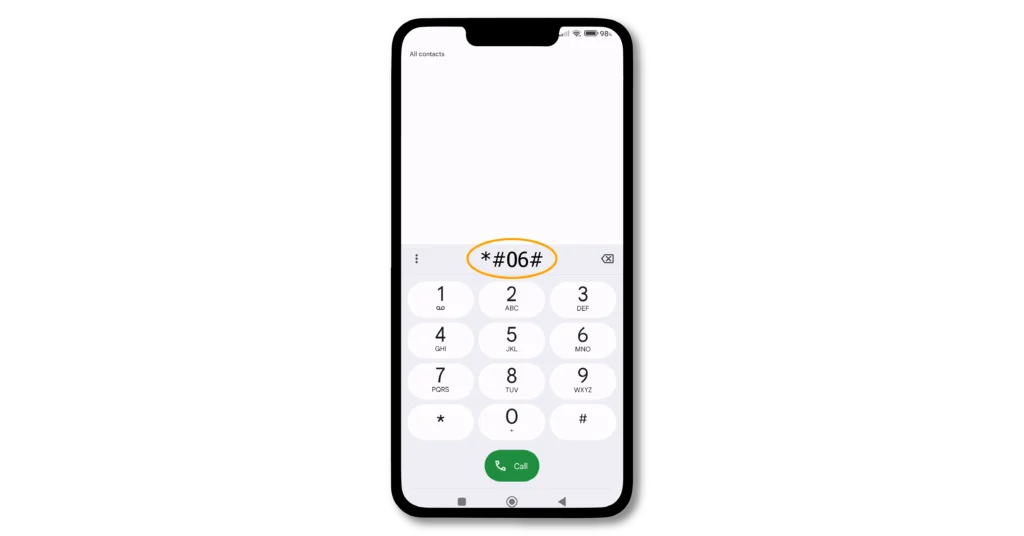
- The IMEI number is often printed on the original packaging, typically on the back of the box or on either side.
- For iOS users, follow these steps:
- open your phone’s Settings app.
- Tap “General”.
- Tap “About”.
- Scroll down to the bottom and look for your IMEI.
- For Android users, follow these step:
- While the steps may vary slightly depending on the vendor, generally you can:
- Open your Phone’s Settings app.
- From Settings, tab “About phone” or “About device”.
- The IMEI number may be displayed directly. If not, you might need to tap “Status”, or “All specs” and then select “Status” to find it.
- Another method is through Google Find My Device. From the main page, press the gear or info icon, and your phone’s IMEI will be displayed along with the Model Number.
What to Do with Stolen or Lost Phones?
If your mobile device is stolen or lost, report it to your local network carrier to blacklist your IMEI number, preventing it from operating on the network. This ensures that the device cannot be used on the cellular network until it is recovered and you inform your carrier that the device has returned to its original owner.
This action helps protect you from paying for unauthorized calls, which can be very expensive, and may keep you safe from being implicated in illegal activities associated with your mobile device.
Illegal Actions with IMEI
There are a several illegal activities related to IMEI numbers. Avoid engaging in any lawful actions. Here are few of them:
- Changing the IMEI number of a mobile device to another valid IMEI number of a different device to:
- Access and use the cellular network from a blacklisted (for some reason) device.
- Bypass registration fees required by network carriers in some countries. In some countries, cellular network carriers restrict new and unregistered cell phones from operating on the network.
- Using someone else’s IMEI number to engage in illegal activities, which can lead to penalties and potential legal repercussions.
IMEI Free Online Checkers
There are a several free online checkers for IMEI numbers that allow you to input your IMEI number and perform a check:
With an IMEI check, you can find out:
- The manufacturer of the device.
- The Model Number of the device.
- Whether the device is blacklisted, meaning it cannot access or use a cellular network.
- Whether the device is locked, meaning it can only operate on a specific cellular network.
Some websites also offer additional services or display the mobile device specifications.
Additional Resources
If you would like to learn about IMEI, and what to do if a manufacturer has a prototype mobile device and needs to apply for a temporary IMEI number, refer to the official documentation on the allocation and approval process of IMEI numbers.
This documentation outlines the different applications for obtaining an IMEI, whether permanent or temporary, and lists the Reporting Body Identifiers along with their names.
It is important to note that only manufacturers can request a temporary IMEI (Test IMEI) from regional authorized bodies for experimental purposes.
Conclusion
- An International Mobile Equipment Identity (IMEI) number is a globally unique identifier assigned to individual mobile devices.
- IMEI numbers are tied to the mobile device, not to the SIM card.
- An IMEI number consists of 15 decimal digits, ranging from 0 to 9.
- Dial
*#06#from your device to view your IMEI number(s). - The Reporting Body Identifiers are managed and assigned by the GSM Association (GSMA), which oversees the assigning IMEI numbers to mobile device models.
- IMEI numbers play a crucial role in preventing stolen mobile phones from accessing and being used on cellular networks.
- The additional component often presented alongside the IMEI number is the Software Version Number (SVN).




